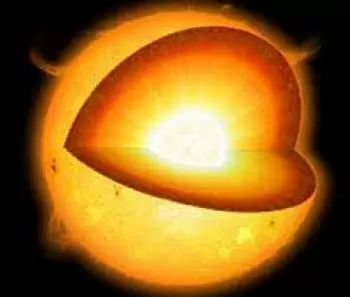
The Sun is the star located in the center of the Solar System. Equipped with a huge mass and animated by continuous nuclear reactions within itself, it forces any body in our planetary system to orbit around it.
The solar structure is made up of six layers divided into two main groups: the inner layers and the outer layers of the Sun. In this article we analyze the layers and areas inside the Sun.
Our star is approximately 150 million kilometers from Earth. The energy generated in the solar core reaches the Earth's atmosphere through electromagnetic radiation.
Solar core
The core of the Sun is the true "engine" of our star and, consequently, of the entire Solar System. It is characterized by high pressure, a pressure equal to about 500 billion atmospheres caused by its own magnetic field.
The high pressure of the nucleus enables nuclear fusion reactions to be triggered at high temperature (proton-proton reaction) in which hydrogen atoms are converted into helium and release an enormous amount of energy. For every helium nucleus that is formed, 600 billion calories are produced.
Every second that passes, the solar core generates 3.86 × 10 26 Joules of energy by transforming 600 million tons of hydrogen into helium.
What is the density of the solar core?
The density of the core is close to 150,000 kg / m 3 .
This density is one hundred and fifty times denser than liquid water.
What is the temperature of the Sun's core?
At the core it reaches a temperature of around 15 million degrees Celsius.
It is the highest temperature in the Sun and is due to the large number of nuclear fusion reactions that take place inside.
The radiant zone
The layer that surrounds the nucleus is called the radiative zone because it performs a filtering function on the particles and photons that carry energy. These particles are released by nuclear reactions. The exception to the rule is neutrinos, which cannot escape to the outside without any interaction.
In this case, the reactions that take place inside the nucleus produce electromagnetic waves and gamma rays that are absorbed by the surrounding layer, to then be re-emitted by radiation towards the outermost layers.
This radiative process takes a long time, on the order of a million years because these photons are continuously absorbed and re-emitted in a different direction than the one they had.
The convective zone
The action exerted by the radiant layer causes the energy transported by the photons to decrease considerably. When the energy level of the photons coincides with the thermal energy of the solar matter, the phenomenon of convection is imposed, which occurs in correspondence with the convective layer, in which the energy is transported by the solar matter and no longer by the range of rays.
What are the outer layers of the Sun?
The outer layers of the Sun are the photosphere, chromosphere and solar corona.
The photosphere is a thin layer about 300 km thick that generates visible light and where sunspots are seen.
The chromosphere is a colder layer than the other layers of the Sun and is characterized by its reddish color. From time to time it emits jets of gas sometimes flying through the chromosphere.
The corona is the outermost part of the solar atmosphere. The temperature of the corona is much higher than the temperature of the photosphere. When observing a total solar eclipse, the solar corona can be seen shining in space.
Coronal mass ejections leave the corona, which are waves made of radiation and solar wind that is released from the Sun in the period called Maximum Solar Activity.